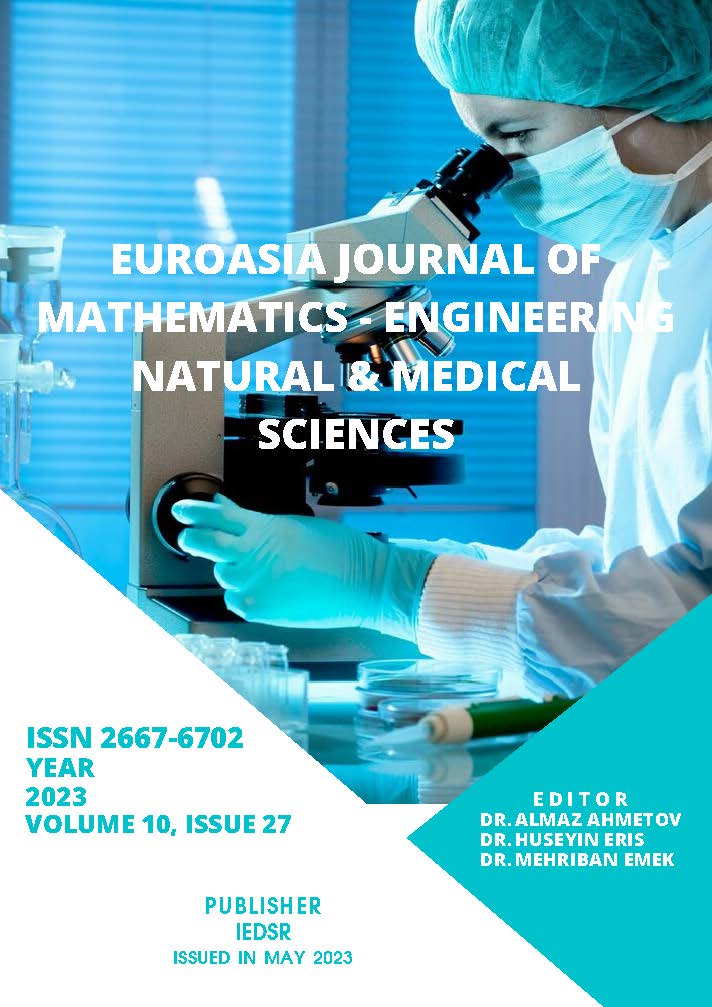Investigation of Blood Mineral Levels in Patients with Type 2 Diabetes Mellitus with Non-Nephopathy
DOI:
https://doi.org/10.5281/zenodo.7968993Keywords:
Mineral, type 2 diabetes mellitus, glomerular filtration rateAbstract
Type 2 diabetes mellitus (T2DM) is a metabolic disease characterized by high blood sugar as a result of decreased insulin secretion from the pancreas or the development of insulin resistance in peripheral tissues. Complications due to glucotoxicity develop in many tissues, especially kidney and eye, due to high blood sugar. Minerals are essential nutritional components for the basic structure and functions of the body. The most important are calcium, potassium, sodium, phosphorus, magnesium and chlorine. Diabetes mellitus is the most common cause of chronic renal failure in our country and in the world. Depending on diabetic nephropathy, changes in blood mineral levels that can cause morbidity and even mortality are observed. Therefore, the determination of blood mineral levels in T2DM patients with normal glomerular filtration rate (GFR) is worth investigating. In the study, the files of the patients who applied to the internal medicine outpatient clinic of our hospital were reviewed retrospectively. The cases were divided into 2 groups as T2DM diagnosis and control group. 102 patients (44 females, 51 males) diagnosed with T2DM and 95 healthy cases (48 females, 54 males) were included in the study. In the group with T2DM diagnosis, sodium level 139 (136-141) mEq/L, potassium 4.8 (4.6-5.1) mEq/L, chlorine 99 (96-100.7) mEq/L, calcium 9.4 (9.1- 9.7) mg/dL, phosphorus 4.1 (3.9-4.3) mg/dL, magnesium 1.4 (1.3-1.6) mg/dL. In the control group, sodium level is 140 (138-142) mEq/L, potassium 3.8 (3.6-3.98) mEq/L, chlorine 98 (96.7-100) mEq/L, calcium 8.8 (8.6-9) mg/dL, phosphorus 3.2 (2.9-3.6) mg/dL, magnesium 2 (1.9-2.2) mg/dL. There was a statistically significant difference between the calcium, phosphorus, potassium and magnesium levels of both groups. Diabetic nephropathy is one of the most important complications of T2DM. Defects in mineral levels occur secondary to nephropathy. In this study, differences were found in the significant phosphorus, potassium and magnesium levels of patients with T2DM with normal GFR levels compared to the control group. This result shows that even before the development of diabetes-related nephropathy, changes in blood mineral levels begin compared to healthy individuals.
References
Satman I. et al., Population-based study of diabetes and risk characteristics in Turkey. Diabetes care, 2002. 25(9): p. 1551-1556.
Colwell JA. Pharmacological strategies to prevent macrovascular disease in NIDDM. Diabetes. 1997; 46(2): S131-4.
Tas A, Bayraktar M, Erdem U, Sobaci G, Ucar M. Diyabetik hastalarda retinopati sıklığı ve risk faktörleri. Gülhane Tıp Dergisi. 2005; 47(3): 164-74.
Newman DJ, Mattock MB, Dawnay AB, Kerry S, McGuire A, Yaqoob M, et al. Systematic review on urine albumin testing for early detection of diabetic complications. Health Technol Assess. 2005; 9(30): iii-vi, xiii-163.
Clinical practice guidelines and clinical practice recommendations for diabetes and chronic kidney disease. Am J Kidney Dis. 2007; 49(2 suppl 2): s12.
Young, V.R. Trace element biology: The knowledge base and its application for the nutrition of individuals and populations. J. Nutr. 2003, 133 (Suppl. 1), 1581S–1587S.
Wolide, A.D., Zawdie B., Alemayehu T., Tadesse S. Association of trace metal elements with lipid profiles in type 2 diabetes mellitus patients: A cross sectional study. BMC Endocr. Disord. 2017; 17, 64.
Tinkov A.A., Sinitskii A., Popova, E., Nemereshina O., Gatiatulina E., Skalnaya M.G., Skalny A.V., Nikonorov A. Alteration of local adipose tissue trace element homeostasis as a possible mechanism ofobesity-related insulin resistance. Med. Hypotheses 2015, 85, 343–347.
American Diabetes Association. 2. Classification and Diagnosis of Diabetes. Diabetes Care 2017; 40:S11.
Hillier TA, Abbott RD, Barrett EJ. Hyponatremia: evaluating the correction factor for hyperglycemia. Am J Med (1999) 106:399–403. doi: 10.1016/s0002-9343 (99)00055-8.
Liamis G, Rodenburg EM, Hofman A, Zietse R, Stricker BH, Hoorn EJ: Electrolyte disorders in community subjects: Prevalence and risk factors. Am J Med 2013;126:256-263.
Manavalan JS, Cremers S, Dempster DW, Zhou H, Dworakowski E, Kode A, et al. Circulating osteogenic precursor cells in type 2 diabetes mellitus. J Clin Endocrinol Metab (2012) 97:3240–50.
Palmer BF: Managing hyperkalemia caused by inhibitors of the renin- angiotensin-aldosterone system. N Engl J Med 2004;351:585- 592.
Yang L, Frindt G, Palmer LG: Magnesium modulates ROMK channel-mediated potassium secretion. J Am Soc Nephrol 2010;21:2109-2116.
Thomson SC et al. Acute and chronic effects of SGLT2 blockade on glomerular and tubular function in the early diabetic rat. Am. J. Physiol. Regul. Integr. Comp. Physiol 2012; 302, R75–R83.
Andanappa Gadad, Stephanie Mohammed, Venkatesan Sundaram. Identification of calcium, sodium, magnesium and chloride ion levels in hypertensive and non-hypertensive trinidadians. Int J Biochem Mol Biol. 2019 Aug 15;10(3):17-22.
Yamaguchi T, Kanazawa I, Takaoka S, Sugimoto T: Serum calcium is positively correlated with fasting plasma glucose and insulin resistance, independent of parathyroid hormone, in male patients with type 2 diabetes mellitus. Metabolism 2011, 60(9):1334–1339.
Sun G, Vasdev S, Martin GR, Gadag V, Zhang H: Altered calcium homeostasis is correlated with abnormalities of fasting serum glucose, insulin resistance, and beta-cell function in the Newfoundland population. Diabetes 2005, 54(11):3336–3339.
Frost M, Abrahamsen B, Nielsen TL, Hagen C, Andersen M, Brixen K: Vitamin D status and PTH in young men: a cross-sectional study on associations with bone mineral density, body composition and glucose metabolism. Clin Endocrinol (Oxf) 2010, 73(5):573–580.
Farrow EG, White KE. Recent advances in renal phosphate handling. Nature reviews Nephrology. 2010;6(4):207-17.
R Kebler, F D McDonald, P Cadnapaphornchai. Dynamic changes in serum phosphorus levels in diabetic ketoacidosis. Am J Med. 1985 Nov;79(5):571-6.
Liamis G, Liberopoulos E, Barkas F, Elisaf M: Diabetes mellitus and electrolyte disorders. World J Clin Cases 2014;2:488-496.
Nikolay Mironov, Mainul Haque, Azeddine Atfi, Mohammed S Razzaque. Phosphate Dysregulation and Metabolic Syndrome. Nutrients. 2022 Oct 25;14(21):4477.
Barbagallo M, Belvedere M, Di Bella G, Dominguez LJ. Altered ionized magnesium levels in mild-to-moderate Alzheimer's disease. Magnes Res. 2011;24:S115–21.
Simi Patoa, Dwijen Das. Serum Magnesium Levels and its Association with Glycated Hemoglobin in Type 2 Diabetes Mellitus Patients. J Assoc Physicians India. 2022 Apr;70(4):11-12.
Downloads
Published
How to Cite
Issue
Section
License
Copyright (c) 2023 Euroasia Journal of Mathematics, Engineering, Natural & Medical Sciences

This work is licensed under a Creative Commons Attribution-NonCommercial 4.0 International License.


